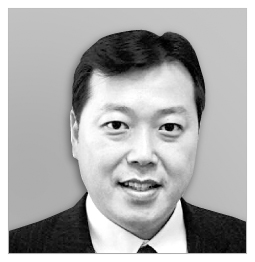Why no salute here?

The author is the Washington bureau chief of the JoongAng Ilbo.
“It was almost automatic. My left hand went up to my forehead without [a second thought,] it never was planned, put it that way,” said former Senator Bob Dole. He saluted with his left hand in front of the casket of former U.S. President George H. W. Bush on Dec. 4. The World War II veteran has limited mobility in his right arm and numbness on his left arm. He could only move three of his fingers. But his saluting impressed many Americans in the rough era of the Trump presidency. What really made 95-year-old Dole stand up from his wheelchair and automatically lift his left hand?
Dole and Bush were arch rivals. Bush is from a wealthy family, while Dole comes from a humble background. Bush secretly considered running for vice president at the 1976 Republican National Convention, but Dole became Gerald Ford’s running mate. Knowing that Bush wanted the nomination, Dole intentionally summoned Bush, then the CIA director, and forced him to brief him on national security. Bush gnashed. During the 1988 Republican primary, the two fought intensely. At a live televised debate in New Hampshire, Dole warned, “Stop lying about my record!” That night, Bush wrote in his diary how useless Bob Dole was. But the situation changed. Upon being elected president, Bush told Dole he needed him.
In 1992, when Bush failed to be reelected, Dole invited him to a dinner during which he offered him words of consolation. Soon after, Dole received the following letter:
“Dear Bob,
When you invited me, I didn’t want to come. I didn’t think I could face the music. But now I am so glad you asked me. The warmth of your generous remarks made it all so worthwhile. You have been a truly noble leader, and as I leave Washington I will take with me a friendship I value — a respect for a true leader I’ll always feel. Thanks, Bob. George.”
Dole’s salute reminded me of a scene I witnessed at a small room in Japan in the spring 2006. Ryuzo Sejima, 95, got out of his wheelchair when Park Tae-jun walked in and saluted him. Park was surprised and returned the salute. Sejima graduated first from the military academy and spent 11 years in Siberia as a prisoner of war, having been captured by the Soviet army during the Pacific War. The novel “Fumo Chitai” was based on his life as a military officer and later a successful businessman. He represented Japan’s economic prosperity, but apologized for Japan’s cruelty to Korea. Park embraced Sejima. In the following year, Sejima died. His final salute captures the deep friendship, respect and agony that the two men shared.

Former U.S. Senate Majority Leader Bob Dole, center, salutes before the casket bearing the remains of former U.S. President George H. W. Bush in the U.S. Capitol in Washington on Tuesday. [EPA/YONHAP]
Conviction is such that the game is not over until someone dies. Who will ever be happy in such a society? Is anyone truly happy? I hope there is someone for whom we automatically lift our hands to salute.
JoongAng Ilbo, Dec. 12, Page 34










with the Korea JoongAng Daily
To write comments, please log in to one of the accounts.
Standards Board Policy (0/250자)